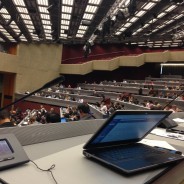Pangolins, agenda item (50), came up in plenary on Tuesday afternoon and as Chair of the CITES inter-sessional working group on pangolins, the EU introduced the report of the working group (agenda item 50.1) to the Standing Committee and all observer Parties and other observers. The recommendations in the report included asking those Parties that hadn’t responded to a questionnaire on pangolin trade and conservation to do so, and for the Standing Committee to recommend a Resolution on the conservation and trade in pangolins be sent to CoP17 for potential adoption by the Parties.
After this report, the US introduced a short report (agenda item 50.2) on the First Pangolin Range States meeting.
After these documents were introduced observer Parties and organisations made various interventions. Niger, Zimbabwe, Botswana, the US, and Portugal all came out supporting the work of the working group and supporting the recommendations proposed. China emphasised that little is known about pangolin populations and more information on this front is needed. Norway also supported the requirements in 50.1, but suggested that the reporting outlined in the working group report may be too heavy at present and suggested the Resolution in the Annex to the working group report be amended to a Decision. India stated that the Indian and Chinese pangolins are included in the WPA 1972 in India and that it supports the listing for all pangolins in Appendix I.
IUCN made the following intervention: Thank you, Chair. In the interests of time I will keep this intervention brief. Regarding Agenda item 50.1 it may help the Standing Committee and Parties to know that last year IUCN published revised Red List assessments for each of the eight species of pangolin, all of which are now threatened with extinction. In these revised assessments, the Chinese pangolin Manis pentadactyla and Sunda pangolin Manis javanica are listed as Critically Endangered, and the Indian pangolin Manis crassicaudata and Philippine pangolin Manis culionensis are listed as Endangered. The African species, the Tree pangolin Manis tricuspis, Long-tailed pangolin Manis tetradactyla, Giant pangolin Manis gigantea and Temminck’s Ground pangolin Manis temminckii are all listed as Vulnerable. The principal threats to the species are illicit hunting and poaching driven primarily by illegal, international trade, and in Africa exploitation for bushmeat and medicinal use. In this regard, and since 2000, there have been over 1,000 reported seizures involving pangolins and their derivatives globally, representing at a minimum 260,000 pangolins in international trade from Africa and Asia. More information can be found in the inf. doc on this matter submitted to SC66. Thank you, Chair.
Interventions then followed from IFAW on behalf of IFAW, HSI, Born Free, Natural Resources Defence Council, Centre for Biological Diversity, Animal Welfare Institute, Annamiticus and the Tikki Hywood Trust broadly supporting findings of the First Pangolin Range States meeting, and the PangolinSG Inf. doc (which was submitted to the Standing Committee meeting by the CITES Secretariat) and this intervention also stated that captive-breeding of pangolins not suitable as a tool for their conservation.
ZSL also made an intervention in which it stated its support for the PangolinSG inf. doc and strong support for the WG recommendations, and is willing to work with the Parties and IUCN, TRAFFIC and UNEP-WCMC on reporting mandates arising in the future.
Save Vietnam’s Wildlife also gave an intervention reiterating the need for action to conserve pangolins and address trade following declines of pangolin species in Vietnam.
Between the plenary session and the working group meeting (which took place on Wednesday evening) the working group Chair liaised with the CITES Secretariat following  plenary discussion and suggested amendments to the Resolution as contained in the working group report, and which included dividing the Resolution into a Resolution and Decision. Following input from various sides in the working group a draft Resolution and Decision went back to plenary as recommendations and were signed off by the Standing Committee. Arguably the biggest change was to the draft outcomes was the timing. Including a reporting mandate in a Decision as opposed to the Resolution (which may or may not be adopted by CoP17) is that, if the Decision is adopted at CoP17, the reporting mandate will be completed by SC69 (2017 – subject to available resources) as opposed to CoP18 only, which will likely take place in 2019. In sum, the next CITES CoP, CoP17 in September, will be asked to adopt the drafted Resolution on pangolin conservation and trade, and the Decision which includes a reporting mandate to SC69 and CoP18 on, inter alia, pangolin status and legal and illegal trade trends. This can be seen as good progress for the species, especially if we think where they were a few years ago.
plenary discussion and suggested amendments to the Resolution as contained in the working group report, and which included dividing the Resolution into a Resolution and Decision. Following input from various sides in the working group a draft Resolution and Decision went back to plenary as recommendations and were signed off by the Standing Committee. Arguably the biggest change was to the draft outcomes was the timing. Including a reporting mandate in a Decision as opposed to the Resolution (which may or may not be adopted by CoP17) is that, if the Decision is adopted at CoP17, the reporting mandate will be completed by SC69 (2017 – subject to available resources) as opposed to CoP18 only, which will likely take place in 2019. In sum, the next CITES CoP, CoP17 in September, will be asked to adopt the drafted Resolution on pangolin conservation and trade, and the Decision which includes a reporting mandate to SC69 and CoP18 on, inter alia, pangolin status and legal and illegal trade trends. This can be seen as good progress for the species, especially if we think where they were a few years ago.
Before all of this took place the PangolinSG hosted a side event on Tuesday lunchtime, which was kindly introduced and moderated by Sue Lieberman (IUCN SSC Steering Committee member) and saw Dan Challender, Co-Chair of the PangolinSG and Lisa Hywood and Nguyen Van Thai, member of the PangolinSG, give presentations on the illegal trade, conservation status and use of pangolins at the global level and in Zimbabwe and Vietnam specifically. The event was well attended and well received and there were some good questions afterwards. The idea was to raise awareness of the issues pangolins face – linked to the SC66 meeting agenda – among Parties and other observers and which was achieved.



